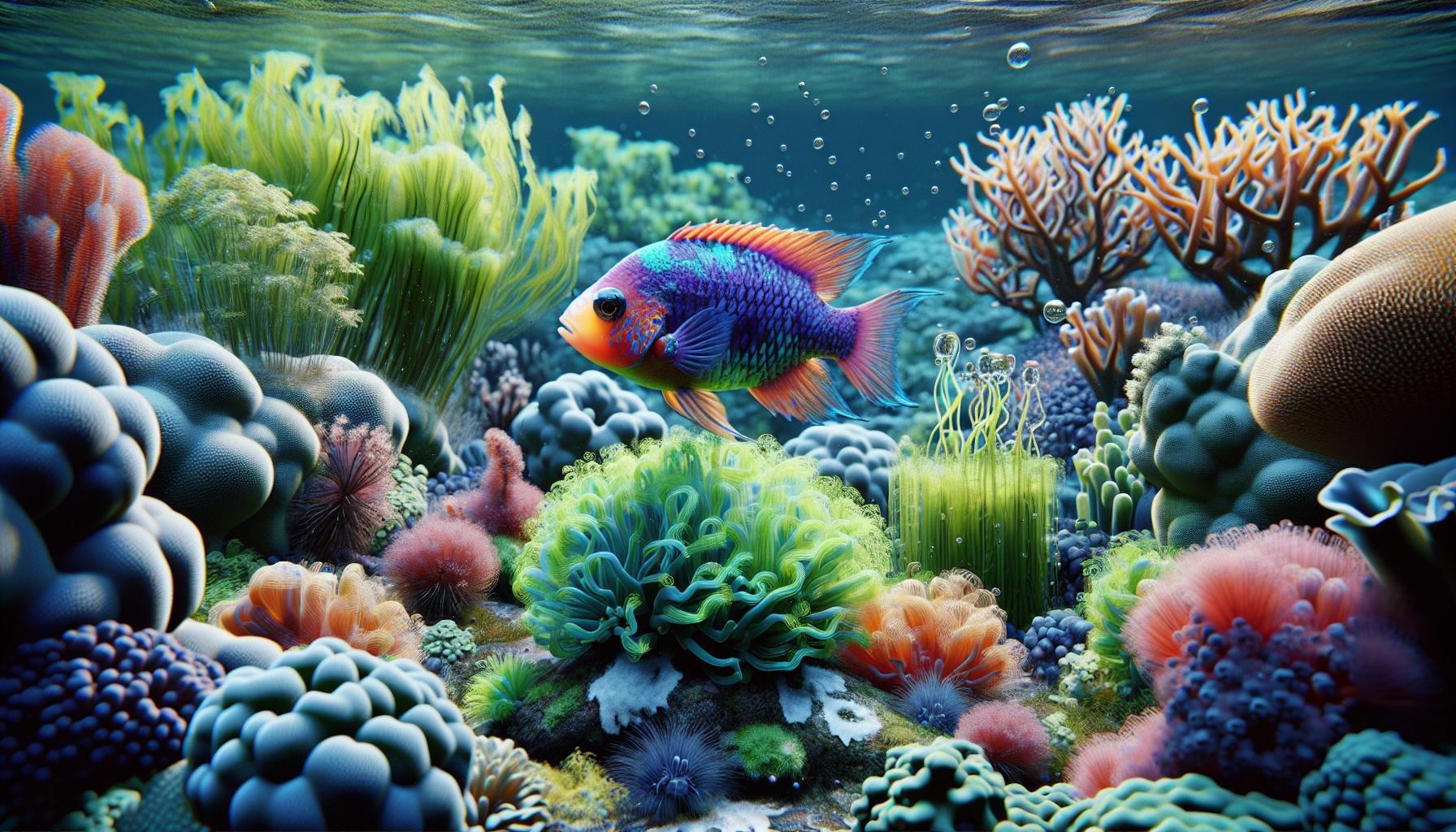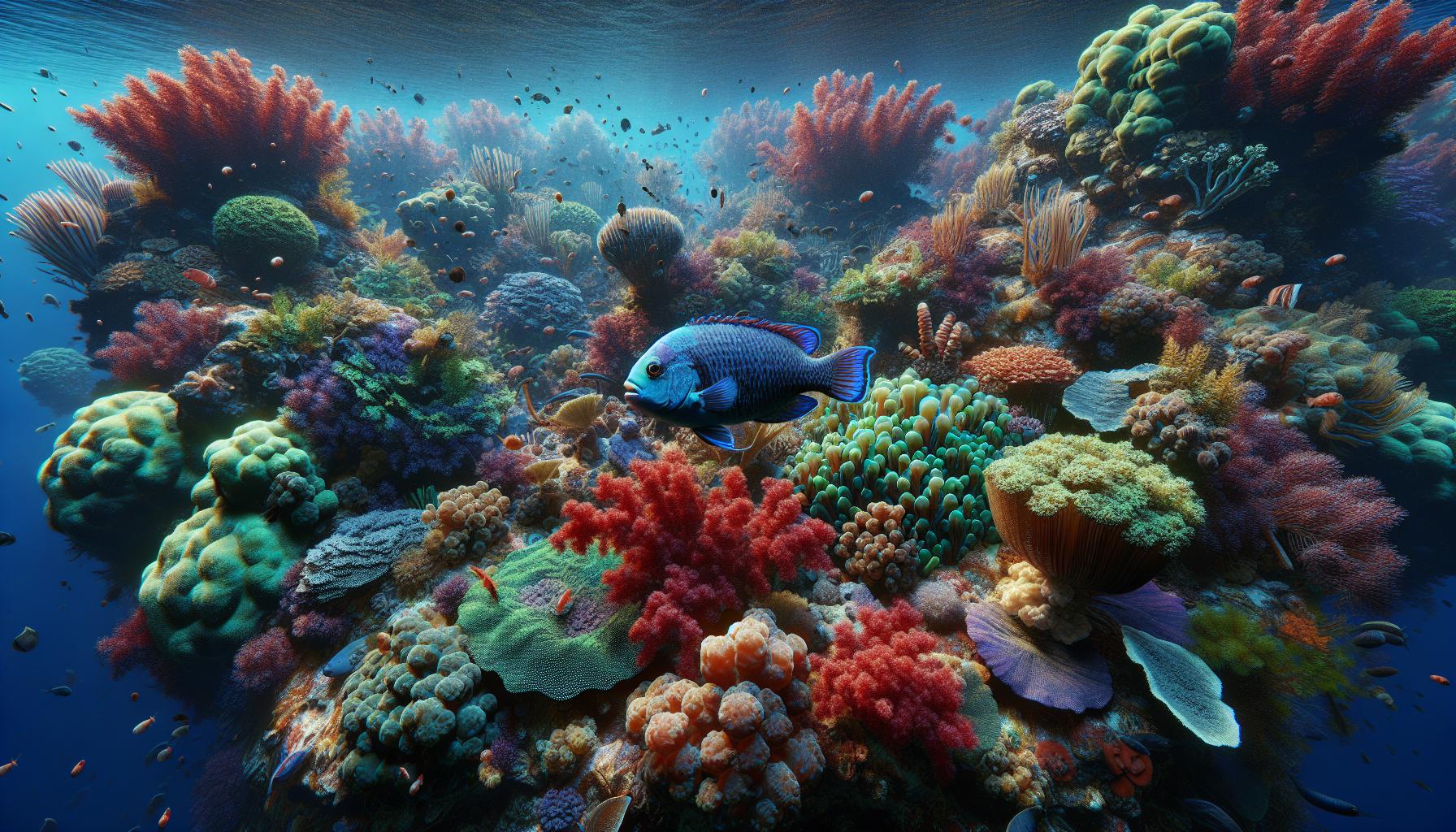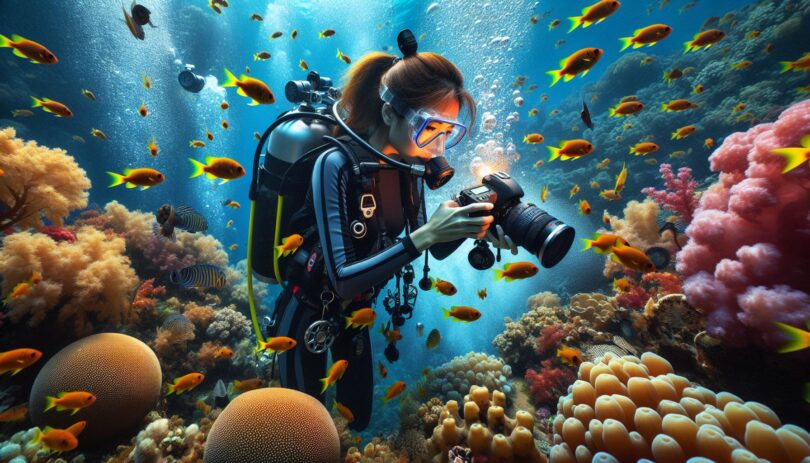Damselfish might just be the unsung heroes of the coral reefs. These small, vibrant fish play a crucial role in their underwater ecosystems, yet they often fly under the radar when we talk about marine life. I’ve always been fascinated by their striking colors and spirited personalities, which make them a favorite among aquarists and snorkelers alike.
But there’s more to damselfish than meets the eye. Beyond their aesthetic appeal, these fish exhibit fascinating behaviors and have interesting survival strategies. Whether you’re a seasoned marine biologist or just someone who loves learning about the ocean, there’s something captivating about these creatures. Let’s dive into the world of damselfish and discover what makes them so special.
Key Takeaways
- Damselfish play a crucial role in maintaining the ecological balance of coral reefs by engaging in activities such as algae cultivation, which promotes biodiversity, and serving as a key food source for predators, keeping the population dynamics in check.
- The vibrant colors and unique patterns of damselfish serve multiple purposes including camouflage, communication, and mate attraction, contributing to the visual splendor and ecological diversity of coral reefs.
- Damselfish exhibit unique behaviors such as territoriality and farming, which are vital for their survival and the health of coral reefs. They aggressively defend their territories and cultivate algae gardens, showcasing their importance in nutrient cycling and ecosystem maintenance.
- The survival strategies of damselfish, including camouflage, color change, and adaptive breeding practices, demonstrate their resilience and adaptability in the face of potential threats within the coral reef ecosystem.
- Studying and observing damselfish requires patience, precision, and a combination of methods such as scuba diving, underwater photography, and collaboration among researchers, highlighting the complexity of their behaviors and their significant impact on coral reef health and biodiversity.
The Role of Damselfish in Coral Reefs

Damselfish, those vibrant sparks of color flickering throughout the reef, play crucial roles in the ecological balance of coral reefs. My fascination extends beyond their colors to their impact on the reef’s health and complexity. Let’s dive deeper into how these small fish make big waves in their underwater world.
One of the most interesting things I’ve learned is that damselfish are like the farmers of the reef. They cultivate algae, their primary food source, in “gardens”. They fiercely defend these patches from other fish, ensuring their crops thrive. This gardening behavior not only provides food for the damselfish but also contributes to nutrient cycling in the reef ecosystem. Through their daily activities, nutrients are redistributed, supporting the diverse life forms that call the reef home.
Moreover, damselfish serve as a vital link in the reef food chain. Predators rely on them as a key food source. This predator-prey relationship is essential for keeping the reef population in balance. Without damselfish, the structure of the reef ecosystem could change drastically, highlighting their significance in maintaining ecological harmony.
Research has revealed some fascinating statistics about damselfish populations and their impact on coral reefs:
| Factor | Impact |
|---|---|
| Algae Cultivation | Enhances biodiversity by supporting a variety of marine life. |
| Predation | Maintains the balance of species within the reef ecosystem. |
| Nutrient Redistribution | Promotes coral health and supports the reef’s resilience to environmental stresses. |
In essence, damselfish are more than just pretty faces in the underwater community. They’re workhorses that contribute significantly to the health and sustainability of coral reefs. Their role in nutrient cycling, as both prey and gardener, showcases the interconnectedness of marine ecosystems. As I continue to explore the wonders of the ocean, it’s clear that understanding creatures like damselfish is key to appreciating and protecting these vibrant underwater cities.
The Colorful World of Damselfish

Diving into the vibrant habitats of coral reefs, I’ve always been fascinated by the dazzling array of colors and forms of marine life. Among these, damselfish stand out with their vivid hues and dynamic behaviors. These small, yet brightly colored fish play a pivotal role in the ecosystem, adding not only to the visual splendor of the reefs but also to their ecological diversity.
Damselfish, belonging to the Pomacentridae family, are known for their striking colorations which can range from deep blues and greens to vibrant yellows and oranges. The purpose of these colors is multifaceted; they serve as camouflage, a means of communication, and as a way to attract mates. Each species flaunts a unique pattern, making them a subject of interest not just for marine biologists but for snorkelers and divers alike.
| Region | Number of Species |
|---|---|
| Caribbean | over 30 |
| Pacific Ocean | over 70 |
| Worldwide | over 300 |
The wide distribution and diversity of damselfish species across the globe highlight their adaptability to various reef environments. From shallow lagoons to deeper coral reefs, these fish have carved out a niche for themselves, contributing significantly to the coral ecosystem.
In my observations, one cannot help but admire the resilience and tenacity of these small fish. Their colorful presence is not just decorative; it signifies the health and well-being of coral reefs. By understanding the colors and behaviors of damselfish, we delve deeper into the complexities of marine life, witnessing firsthand the beauty and challenges of underwater ecosystems. As I continue to explore and document the life of damselfish, their vibrant world remains a constant source of wonder and intrigue, reminding us of the intricate connections that sustain life beneath the waves.
Unique Behaviors of Damselfish

As I continue to dive deeper into the fascinating world of damselfish, it’s impossible not to be intrigued by their unique behaviors. These small, yet vibrant creatures of the sea showcase a range of activities that are not only crucial for their survival but also for the health of coral reefs.
One of the most notable behaviors of damselfish is their territorial nature. They are fiercely protective of their home territory within the coral reefs. This behavior plays a key role in the maintenance and growth of coral, as damselfish often cultivate algae gardens which they guard with great vigor. Their dedication to these algae patches ensures a balanced ecosystem, contributing significantly to the biodiversity of the reef.
Additionally, damselfish exhibit an interesting trait known as farming. They meticulously remove unwanted algae and invertebrates from their territory, promoting the growth of their preferred algae species. This not only provides them with a reliable food source but also enhances the health of the coral by preventing overcrowding and excessive algae growth that can be detrimental.
Their social structure is another aspect that fascinates many. While they can be solitary, during breeding seasons, damselfish become more communal. Their courtship displays are a vibrant spectacle, with males showing off their brightest colors to attract mates. Following mating, male damselfish show a remarkable level of parental care, diligently aerating and protecting the eggs until they hatch.
The resilience of damselfish is evident in their adaptability to changing conditions within the reef. Climate change and habitat degradation pose significant threats to coral reefs worldwide, yet damselfish continue to thrive in a variety of environmental conditions. This adaptability not only speaks to the robustness of damselfish but also underscores their importance in coral reef resilience and recovery efforts.
Understanding these behaviors enhances our appreciation for damselfish and highlights their indispensable role in coral reef ecosystems. Their contributions to reef health and biodiversity are significant, making them a fascinating subject of study for marine biologists and conservationists alike.
Survival Strategies of Damselfish
Exploring the intricacies of damselfish survival tactics is like peeling back layers of an underwater mystery. I’ve observed that these small yet fearless creatures employ a variety of strategies to outwit predators and secure their place within the coral reef’s hierarchy.
Camouflage and Color Change stand out as their first line of defense. Depending on the species and the surrounding environment, damselfish can adjust their coloration to blend in with the coral and algae, effectively becoming invisible to potential threats. This ability not only helps them evade predators but also aids in ambushing prey.
Another fascinating aspect of their survival playbook is their Territorial Nature. Damselfish are fiercely protective of their chosen area, which is often rich in the algae they farm and eat. They’re known to aggressively ward off intruders, including much larger fish, by means of darting attacks, demonstrating that size isn’t always indicative of strength.
Adaptive Breeding Practices
The breeding strategies of damselfish are nothing short of remarkable. They lay their eggs in carefully selected and defended territories, ensuring their offspring have the highest chance of survival. The parents, especially the males, are diligent caretakers, continuously fanning and guarding the eggs against predators and parasites. This parental investment increases the survival rate of their young, a crucial factor for maintaining their population.
Symbiotic Relationships
Damselfish don’t just rely on their wits and aggression to survive; they’re also adept at forming strategic partnerships. Some species have a symbiotic relationship with larger, more aggressive fish species, offering them food in exchange for protection. Others collaborate with cleaning stations, getting rid of parasites while providing nourishment to their cleaners. These relationships are essential in the highly competitive coral reef environment, showcasing the complexities of underwater ecosystems.
In understanding the survival strategies of damselfish, I’ve gained a deeper appreciation for their role in the delicate balance of coral reef ecosystems. Their resilience and adaptability are testament to the evolutionary wonders of marine life, highlighting the importance of conserving these vibrant underwater communities.
Studying and Observing Damselfish
When I first embarked on my journey to study damselfish, I quickly realized the importance of patience and precision. Observing these fascinating creatures requires a methodical approach, especially considering their vibrant roles within coral reef ecosystems. One does not simply stumble upon the intricate behaviors of damselfish; it requires dedication and, often, innovative observation techniques.
In my experiences, scuba diving and snorkeling have proven to be indispensable tools in studying damselfish. Immersing myself in their natural habitat allows for direct observation of their interactions with the environment and other species. It’s thrilling to witness their territorial defenses unfold or to catch a glimpse of their breeding rituals. However, underwater photography and videography have truly revolutionized the way we can document and analyze these behaviors. High-resolution images and videos provide invaluable data that can be reviewed and shared with peers, greatly enhancing our understanding of damselfish dynamics.
Field note exchanges and collaborations with other researchers are equally vital. By sharing observations and data, we can piece together a more comprehensive picture of damselfish behaviors and their ecological impacts. This collective effort has led to several breakthroughs in understanding how these fish influence coral reef health and biodiversity.
Moreover, advancements in aquarium technologies enable detailed observations in controlled environments. This not only serves the purpose of research but also educates the public about the complexities of underwater ecosystems. Through carefully designed tanks that mimic natural conditions, observing the subtle nuances of damselfish behavior becomes accessible to everyone.
As we continue to delve deeper into the world of damselfish, it’s clear that our methodologies must evolve to keep pace with the dynamic nature of coral reefs. The insights gained from studying damselfish not only enrich our knowledge but also underscore the importance of preserving these underwater communities.
Conclusion
Diving into the world of damselfish has been an enlightening journey. Their role in the coral reef ecosystem is as colorful and varied as their own vibrant hues. Through patience, precision, and the latest technological tools, we’ve been able to peel back layers of mystery surrounding these fascinating creatures. My experiences underscore the critical need to protect our underwater realms. By sharing knowledge and fostering collaboration among researchers, we can continue to uncover the secrets of damselfish and their habitat. Let’s cherish and preserve these underwater communities for generations to come. Their survival is intricately linked to the health of our planet’s oceans, and it’s a responsibility we all share.
Frequently Asked Questions
What unique behaviors do damselfish exhibit?
Damselfish display unique behaviors such as cultivating algae farms on coral reefs and aggressively defending their territory. These behaviors are crucial for maintaining the health and biodiversity of reef ecosystems.
How are damselfish important to coral reefs?
Damselfish play a vital role in coral reef ecosystems by fostering biodiversity through their algae farming activities and by helping in the cycling of nutrients, which promotes healthy coral growth.
What methods are used to study damselfish?
Researchers study damselfish using scuba diving, snorkeling, underwater photography, and videography. These methods allow for direct observation of their interactions with the environment and other species.
Why is collaboration important in studying damselfish?
Collaboration allows researchers to exchange field notes and share insights, leading to a more comprehensive understanding of damselfish behaviors. It promotes the pooling of resources and expertise, enhancing the quality of research.
How has aquarium technology contributed to damselfish research?
Advancements in aquarium technology allow for detailed observations of damselfish in controlled environments. This not only aids in research but also educates the public about the complexities of underwater ecosystems and the need for conservation.
Why is it important to preserve underwater communities like those inhabited by damselfish?
Preserving underwater communities is crucial because they support biodiversity, contribute to the health of our planet, and provide valuable insights into coral reef dynamics. Conservation efforts help ensure the sustainability of these ecosystems for future generations.

